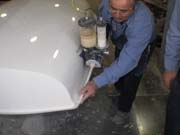Smooth Sailing

The MIXPAC DX system, which includes a handheld DXH dispenser, a DXR refill station and a variety of static mixers, is easy to use and offers the simplicity of cartridge systems, as well as the cost-effective benefits of purchasing adhesives and sealants in larger quantities. In addition, point-of-application metering dispenses a fixed ratio of A/B components directly into a static mixer, which eliminates lead/lag problems. Unlike traditional meter, mix and dispense equipment, the system removes concerns about off-ratio conditions attributed to long fluid lines.
Vanguard Sailboats, Portsmouth, RI, the world's leading manufacturer and largest U.S. supplier of recreational and high-performance small sailboats, uses a MIXPAC DXH dispenser and DXR Refill Station as part of its sailboat manufacturing process.
Vanguard works to perfect complex manufacturing processes that produce hundreds of boats identically. The consistency the company needs to build a large number of affordable, handcrafted boats derives from its continuous investments in equipment, process controls and tooling.
Vanguard sailboats are manufactured by using carefully controlled processes that primarily involve laminating and molding fiberglass to produce the key components of a boat: hull, deck, cockpit, foredeck, rudder, centerboard, and board cap.
Dispensing System Ensures Uniform Products
DXH handheld dispensers, an integral part of the system, were developed to simplify the use of two-component adhesives or sealants. Refill stations were designed to make refilling DXH handheld dispensers a reliable, clean and safe operation. These dispensers are available in 1:1, 1.5:1, 2:1, 4:1 and 10:1 ratios.DXR refill stations consist of two transfer pumps, a docking unit for DXH dispensers, quick-connect refill couplings and control panels mounted on a mobile platform. The refill station is pneumatically operated and controlled. Most common 5-gal (20-liter) bulk containers of adhesive or sealant material can be accommodated by the DXR refill station.
Handheld point-of-application DXH dispensers, which are pneumatically driven, provide compact design, low weight and complete mobility. The result is a range of highly economic dispensing systems.
ITW Plexus supplies adhesives for the Vanguard boat application. "The MIXPAC DX system broadens my choice of meter, mix and dispense machines," says Peter Carbutt, Technology Manager at ITW Plexus. "It allows for more mobility than any system on the market, and is ideal for applications with multiple users."
The system also includes metering pumps, which draw components from pressure-assisted containers. They dispense a fixed ratio of the components through a static mixer in shot or bead form; components can include epoxies, polyurethanes, acrylics, silicones and polysulfides. Applications range from bonding, sealing and encapsulation to crack injection and prototyping, among other functions.
Refill stations provide many benefits, such as easy refilling of the A/B component containers. The MIXPAC DX System combines the cost benefits of bulk material use with the advantages of point-of-application metering. Lower production costs, ease-of-use and reproducible processes are evident. The ability to use bulk-packaged materials allows for immediate cost advantages, as well as the fast refilling of the two containers totaling 1 liter mounted on the handheld dispenser, which streamlines the dispensing operation. Low-maintenance requirements and the use of a refill station to serve multiple handheld dispensers also provide cost advantages.
"The point-of-application metering equipment has markedly increased Thompson's manufacturing efficiencies," says Gary Carr, Operations Manager at Manchester Plastics Division. "Our operators like its light weight and flexibility, since the systems can be moved easily around the plant."
The ergonomically designed MIXPAC DX System is mobile, versatile, safe and easy to refill on site. Features like mode control for bead or shot dispensing, fixed-shot-volume adjustment and point-of-application metering ensure that users can achieve reproducible manufacturing processes, a key ingredient to Vanguard's one-design philosophy.

Sailing Away
Vanguard's products have been sailing for over 50 years. In 2004, Vanguard sold more than 2,800 sailboats. Its products include the Laser, Sunfish, 420, Vector, Zuma and Vanguard Nomad sailboats. The firm also supplies a range of accessories and services to the worldwide sailboat market.The company's dominant position in the international small sailboat market, as well as its active role in supplying and influencing the Olympics and other international sailing competitions, speaks strongly to Vanguard's recognized leadership role and product quality.
Established in 1967 by Peter and Olaf Harken, Vanguard has designed an extensive array of products, from boats used for competitive adult, collegiate and youth sailboat racing to the 17-foot Nomad daysailing boats that can carry 2-6 people.
In 1986, a partnership between Steve Clark, Vanguard's chairman and a world-champion sailor, and Chip Johns, Vanguard's president, purchased the company and moved it from Wisconsin to Rhode Island. They expanded the Vanguard product line, strengthened the company's role as a major supplier of boats for international competitions and are responsible for bringing the company to its dominant international position.
1996 saw the purchase of the Sunfish, Laser and other sailboat product lines from Sunfish Laser Inc., which greatly expanded Vanguard's product set and brought the company to an international leadership position with the acknowledged strongest array of racing and recreational sailboats in North America. To construct fiberglass boat sections, Vanguard's boat builders apply a wax to the interior surfaces of a fiberglass mold, which later facilitates quick release of the molded part after curing.When the waxing is done, a polyester-based material called "gelcoat" - a plastic-based marine paint - is sprayed over the internal surface of the mold. This becomes the external surface of the fiberglass sailboat section and is an integral part of the finished laminate. Individual pieces of fiberglass - mat, knitted, or woven, depending upon the type of boat and particular section - are saturated with a resin that is applied with rollers. These pieces are squeezed of excess resin and layered to the design thickness, the mold is clamped together, and curing occurs in about 45 minutes. After the piece is removed from the mold, it is trimmed, cleaned and later sanded and finished as needed.
Vanguard uses the MIXPAC DXH dispenser and DXR Refill Station as a cost-effective way to attach the rub rail (a vinyl strip that provides an outer protective bumper around the boat's deck), to bond a foredeck to the deck, and to attach the board cap to the hull, which is the cap that encloses the boat's centerboard.
"A DXH handheld dispenser allows Vanguard to use economical bulk-packaged materials and simplifies bead dispensing," says Steve Perry, Vanguard VP of Operations.
Other Applications
DXH dispensers are used in many applications in the industrial, aviation, oil and gas, automobile, truck, mobile home, and marine industries. Vanguard and other international manufacturers are realizing higher productivity and cost savings by selecting reliable and economical MIXPAC DX systems. Companies using these systems for manufacturing and service applications include the following.- A United Kingdom company that builds truck bodies and trailers for temperature-controlled and dry-freight operations.
- An international subsidiary that performs various maintenance services for offshore and other petrochemical installations.
- Several companies that design and build interior equipment, such as storage bins, interior trim, lavatory units, and sinks, for use in aircraft, touring vans, and trailers.
- A multinational firm whose pharmaceutical division produces artificial heart valves.
Whether being used to manufacture competition-level sailboats, fabricate sinks for aircraft, mobile homes and touring vans, or make adhesive dispensing efficient and effective for vendors worldwide, MIXPAC DX systems are playing essential and innovative roles in a range of manufacturing applications.
For more information on dispensing systems, contact ConProTec Inc. 8 Willow St., Salem, NH 03079; phone (603) 893-2727; fax (603) 893-3737; or visit http://www.mixpacusa.com or http://www.statomixusa.com.
Looking for a reprint of this article?
From high-res PDFs to custom plaques, order your copy today!



